|
Centrarchidae
Centrarchidae, better known as sunfishes, is a family of freshwater ray-finned fish belonging to the order Perciformes (formerly belonging to the deprecated order Centrarchiformes), native only to North America. There are eight universally included genera within the centrarchid family: ''Lepomis'' (true sunfishes), ''Micropterus'' (black basses), ''Pomoxis'' (crappies), ''Enneacanthus'' (banded sunfishes), ''Centrarchus'' (type genus, consisting solely of the flier ''C. macropterus''), ''Archoplites'' ( Sacramento perch), ''Ambloplites'' (rock basses), and ''Acantharchus'' (mud sunfish). A genetic study in 2012 suggests that the highly distinct pygmy sunfishes of the genus ''Elassoma'' are also centarchids. The centrarchid family comprises 38 identified species, 34 of which are extant. It includes many popular game fishes familiar to North American anglers, such as the rock bass, largemouth bass, bluegill, pumpkinseed, green sunfish and crappies. Most sunfish are highly valu ... [...More Info...] [...Related Items...] OR: [Wikipedia] [Google] [Baidu] |
Rock Bass
The rock bass (''Ambloplites rupestris''), also known as the rock perch, goggle-eye, red eye, and black perch, is a freshwater fish native to east-central North America. This red eyed creature is a species of freshwater fish in the sunfish family (Centrarchidae) of order Perciformes and can be distinguished from other similar species by the six spines in the anal fin (other sunfish have only three anal fin spines). Distribution Rock bass are native to the St Lawrence River and Great Lakes system, the upper and middle Mississippi River basin in North America from Québec to Saskatchewan in the north down to Missouri and Arkansas, south to the Savannah River, and throughout the eastern U.S. from New York through Kentucky and Tennessee to the northern portions of Alabama and Georgia and Florida in the south. The rock bass has also been found in the Nueces River system in Texas Description They are similar in appearance to smallmouth bass, but are usually quite a bit smalle ... [...More Info...] [...Related Items...] OR: [Wikipedia] [Google] [Baidu] |
Elassoma
''Elassoma'' is a genus of freshwater fish, the only member of subfamily Elassomatinae of the sunfish family Centrarchidae in the order Perciformes. It is sometimes classified as a separate family, the Elassomatidae, in a monotypic suborder, Elassomatoidei, in Perciformes. The type species is ''E. zonatum,'' the banded pygmy sunfish. The Elassomatinae are known collectively as pygmy sunfishes, but are considered by some authorities not to be true sunfishes, which are members of family Centrarchidae. Some researchers believe they are related to sticklebacks and pipefishes (order Syngnathiformes) rather than Perciformes, though genetic research strongly implies a close relationship with the centrarchids. Currently the Integrated Taxonomic Information System classifies them in the family Elassomatidae rather than Centrarchidae. The pygmy sunfishes grow to a maximum overall length of . They occur mostly in temperate and subtropical swamps, marshes, and other shallow, slow-moving ... [...More Info...] [...Related Items...] OR: [Wikipedia] [Google] [Baidu] |
Pygmy Sunfish
''Elassoma'' is a genus of freshwater fish, the only member of subfamily Elassomatinae of the sunfish family Centrarchidae in the order Perciformes. It is sometimes classified as a separate family, the Elassomatidae, in a monotypic suborder, Elassomatoidei, in Perciformes. The type species is ''E. zonatum,'' the banded pygmy sunfish. The Elassomatinae are known collectively as pygmy sunfishes, but are considered by some authorities not to be true sunfishes, which are members of family Centrarchidae. Some researchers believe they are related to sticklebacks and pipefishes (order Syngnathiformes) rather than Perciformes, though genetic research strongly implies a close relationship with the centrarchids. Currently the Integrated Taxonomic Information System classifies them in the family Elassomatidae rather than Centrarchidae. The pygmy sunfishes grow to a maximum overall length of . They occur mostly in temperate and subtropical swamps, marshes, and other shallow, slow-moving ... [...More Info...] [...Related Items...] OR: [Wikipedia] [Google] [Baidu] |
Lepomis
''Lepomis'' or true sunfish is a genus of North American freshwater fish from the family Centrarchidae in the order Perciformes (perch-like fish). The generic name ''Lepomis'' derives from the Greek ("scale") and ("cover", "plug", " operculum"). The genus' most recognizable type species is perhaps the bluegill. Some ''Lepomis'' species can grow to a maximum overall length of , though most average around . Many species are sought by anglers as popular panfishes, and large numbers are bred and stocked in lakes, rivers, ponds and wetlands. They are widely distributed throughout the freshwater lakes and river tributaries of the United States and Canada, and several species have been translocated and flourished around the world, even becoming pests PESTS was an anonymous American activist group formed in 1986 to critique racism, tokenism, and exclusion in the art world. PESTS produced newsletters, posters, and other print material highlighting examples of discrimination in ... [...More Info...] [...Related Items...] OR: [Wikipedia] [Google] [Baidu] |
Largemouth Bass
The largemouth bass (''Micropterus salmoides'') is a carnivorous freshwater gamefish in the Centrarchidae ( sunfish) family, a species of black bass native to the eastern and central United States, southeastern Canada and northern Mexico, but widely introduced elsewhere. It is known by a variety of regional names, such as the widemouth bass, bigmouth bass, black bass, bucketmouth, largies, Potter's fish, Florida bass, Florida largemouth, green bass, bucketmouth bass, Green trout, gilsdorf bass, Oswego bass, LMB, and southern largemouth and northern largemouth. The largemouth bass is the state fish of Georgia and Mississippi, and the state freshwater fish of Florida and Alabama. Taxonomy The largemouth bass was first formally described as ''Labrus salmoides'' in 1802 by the French naturalist Bernard Germain de Lacépède with the type locality given as the Carolinas. Lacépède based his description on an illustration of a specimen collected by Louis Bosc near Charleston, S ... [...More Info...] [...Related Items...] OR: [Wikipedia] [Google] [Baidu] |
Micropterus
''Micropterus'' is a genus of North American freshwater fish collectively known as the black bass, belonging to the sunfish family (biology), family Centrarchidae of order (biology), order Perciformes. They are sometimes erroneously called "black trout", but the name trout more correctly refers to certain members of the salmonid family. The black bass are widely distributed east of the Rocky Mountains, from the Hudson Bay basin in Canada to northeastern Mexico. Several species, notably the largemouth bass, largemouth and smallmouth bass, have been very widely introduced species, introduced throughout the world, and are now considered cosmopolitan (species), cosmopolitan. All black bass species are highly sought-after game fish and well known as strong fighters when angling, hooked, and bass fishing is an extremely popular outdoor sport throughout their native range. Their meat is eaten, being quite edible and firm, although they are not regarded as commercial food fish. All '' ... [...More Info...] [...Related Items...] OR: [Wikipedia] [Google] [Baidu] |
Centrarchiformes
Centrarchiformes is an obsolete order of ray-finned fish, now included amongst the perciformes, with 17 previously included families. This order first appeared about 55.8 million years ago in the Eocene Era, and is composed primarily of omnivores. The order has a wide range that includes the continents of Australia and South America. Many Centrarchiformes look essentially perch-like, featuring a stocky build and a spine-bearing dorsal fin, and range in size from 2.5 cm in length (for '' Elassoma gilberti),'' to 1.8 meters for the '' Maccullochella peelii.'' The order Centrachiformes is not recognized in the 5th Edition of ''Fishes of the World''. Previously included families * Aplodactylidae * Centrarchidae * Cheilodactylidae * Chironemidae * Cirrhitidae * Dichistiidae * Elassomatidae (likely belong within Centrarchidae) * Enoplosidae * Girellidae * Kuhliidae * Kyphosidae * Latridae * Oplegnathidae * Percalatidae * Percichthyidae * Perciliidae * Sinipercidae * Terapon ... [...More Info...] [...Related Items...] OR: [Wikipedia] [Google] [Baidu] |
Angling
Angling is a fishing technique that uses a fish hook or "angle" (from Old English ''angol'') attached to a fishing line to tether individual fish in the mouth. The fishing line is usually manipulated via a fishing rod, although rodless techniques such as handlining and longlining also exist. Modern angling rods are usually fitted with a reel that functions as a cranking device for storing, retrieving and releasing out the line, although Tenkara fishing and cane pole fishing are two rod-angling methods that do not use any reel. The hook itself can be additionally weighted with a dense tackle called a sinker, and is typically dressed with an appetizing bait to attract the fish and enticing it into swallowing the hook, but sometimes an inedible fake bait with multiple attached hooks (known as a lure) is used instead of a single hook with edible bait. A bite indicator, such as a float or a quiver tip, is often used to relay underwater status of the hook to the surface. When ... [...More Info...] [...Related Items...] OR: [Wikipedia] [Google] [Baidu] |
Mud Sunfish
The mud sunfish (''Acantharchus pomotis'') is a freshwater ray-finned fish, a sunfish from the family Centrarchidae, which widely distributed in the fresh waters along the Atlantic coast of North America, ranging from New York to Alabama. It is the only species in the genus ''Acantharchus''. Taxonomy The mud sunfish was first formally described as ''Centrarchus pomotis'' by Spencer Fullerton Baird in 1855 with the type locality given as Cedar Swamp Creek, Beesley's Point, Cape May County, New Jersey and the Hackensack River, Rockland County, New York. In 1864, Theodore Nicholas Gill placed it in its own monospecific genus ''Acantharchus'', the new genus name being a compound of the Greek words meaning "thorn" and meaning "anus". Description The mud sunfish is a small fish which can be distinguished from other members of its family by its possession of 5 or more spines in its anal fin, by having less than 15 gill rakers and in being the only species in its family which has ... [...More Info...] [...Related Items...] OR: [Wikipedia] [Google] [Baidu] |
Ambloplites
''Ambloplites'' is a genus of North American freshwater fish in the sunfish family (Centrarchidae) of order Perciformes. The type species is ''A. rupestris,'' the rock bass, and the species of this genus are known collectively as the rock basses. The various ''Ambloplites'' species, which grow to a maximum overall length of and a maximum weight of , depending on species, are native to a region extending from the Hudson Bay basin in Canada to the lower Mississippi River basin in the United States. Etymology The generic name ''Ambloplites'' derives from the Greek αμβλύς (blunt) and οπλίτης (bearing a shield). Species The currently recognized species in this genus are: * '' Ambloplites ariommus'' Viosca, 1936 (shadow bass) * '' Ambloplites cavifrons'' Cope, 1868 (Roanoke bass) * '' Ambloplites constellatus'' Cashner & Suttkus, 1977 (Ozark bass) * ''Ambloplites rupestris'' (Rafinesque Constantine Samuel Rafinesque-Schmaltz (; October 22, 1783September 18, 18 ... [...More Info...] [...Related Items...] OR: [Wikipedia] [Google] [Baidu] |
Crappie
Crappies () are two species of North American freshwater fish of the genus ''Pomoxis'' in the family Centrarchidae (sunfishes). Both species of crappies are popular game fish among recreational anglers. Etymology The genus name ''Pomoxis'' literally means "sharp cover", referring to the fish's spiny gill covers (opercular bones). It is composed of the Greek (, cover) and (, "sharp"). The common name (also spelled ''croppie'' or ''crappé'') derives from the Canadian French , which refers to many different fishes of the sunfish family. Other names for crappie are papermouths, strawberry bass, speckled bass or specks (especially in Michigan), speckled perch, white perch, crappie bass, calico bass (throughout the Middle Atlantic states and New England), and Oswego bass. In Louisiana, it is called sacalait ( frc, sac-à-lait, ), seemingly an allusion to its milky white flesh or silvery skin. The supposed French meaning is, however, folk etymology, because the word is ultim ... [...More Info...] [...Related Items...] OR: [Wikipedia] [Google] [Baidu] |
Ray-finned Fish
Actinopterygii (; ), members of which are known as ray-finned fishes, is a class of bony fish. They comprise over 50% of living vertebrate species. The ray-finned fishes are so called because their fins are webs of skin supported by bony or horny spines (rays), as opposed to the fleshy, lobed fins that characterize the class Sarcopterygii (lobe-finned fish). These actinopterygian fin rays attach directly to the proximal or basal skeletal elements, the radials, which represent the link or connection between these fins and the internal skeleton (e.g., pelvic and pectoral girdles). By species count, actinopterygians dominate the vertebrates, and they constitute nearly 99% of the over 30,000 species of fish. They are ubiquitous throughout freshwater and marine environments from the deep sea to the highest mountain streams. Extant species can range in size from ''Paedocypris'', at , to the massive ocean sunfish, at , and the long-bodied oarfish, at . The vast majority of Actinoptery ... [...More Info...] [...Related Items...] OR: [Wikipedia] [Google] [Baidu] |




.jpg)





